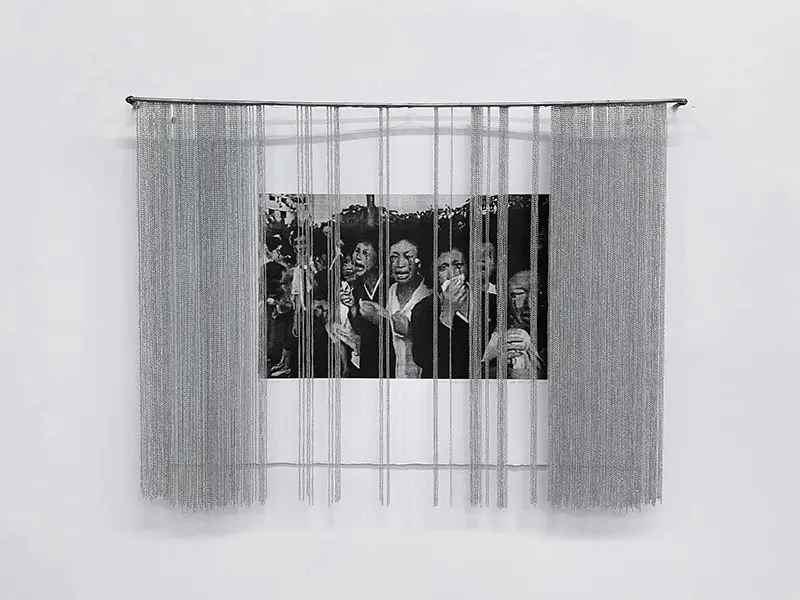The 60th Venice Biennale, titled Stranieri Ovunque (Foreigners Everywhere), is set to make a profound impact on the art world. With an expansive lineup featuring 333 artists, the exhibition underlines diversity and representation through its curatorial approach.
Inspired by Claire Fontaine’s neon sculptures crafted to counter xenophobia in the early 2000s, Adriano Pedrosa’s curation delves into the nuanced dynamics of migration and decolonization in today’s complex global landscape.
Pedrosa emphasizes the dual meaning of the theme, stating, “Wherever you go and whatever your location, you will always encounter foreigners— they/we are everywhere.” Pedrosa suggests that regardless of your location, you are always, deep down, an outsider.

The exhibition’s exploration of the main themes is consistent with Pedrosa’s curatorial statement, which acknowledges “a world full of multiple crises concerning the movement and existence of people across countries, nations, territories, and borders.” The Biennale confronts the perils and pitfalls of language, translation, ethnicity, and the expression of differences, acknowledging the disparities conditioned by identity, nationality, race, gender, sexuality, wealth, and freedom.
The curation comprises two sections: “Nucleo Contemporaneo” showcasing contemporary art and “Nucleo Storico” focusing on historical art. The “Nucleo Contemporaneo” broadens the concept of “foreigner” to include those marginalized for their cultural, sexual, or social identities, featuring works by queer artists such as Erica Rutherford, Evelyn Taocheng Wang, Isaac Chong Wai, and Louis Fratino.
The “Nucleo Storico” segment delves into 20th-century art from Latin America, Africa, Asia, and the Arab world, examining the intersection of European modernism and Indigenous influences. This section includes portraits, abstraction, and the Italian diaspora, showcasing artists like Cícero Dias, Yêdamaria, Rómulo Rozo, Laura Rodig, and Gerard Sekoto.

The exhibition also highlights the contributions of historically persecuted or marginalized artists, with sections dedicated to Indigenous and outsider artists. Notable installations include a monumental mural by the Indigenous Brazilian collective MAHKU – Movimento dos Artistas Huni Kuin and a large-scale work by the Mataaho Collective, representing Māori perspectives.
Some other notable artists include John Akomfrah, recognized for his ambitious film installations, is set to represent Great Britain. Emerging from the Black Audio Film Collective, Akomfrah rose to prominence in the early 1980s. His debut at the Biennale occurred in 2015 with “Vertigo Sea,” a notable three-screen installation exploring themes of whaling and the environment. Four years later, he returned to Venice with “Four Nocturnes,” featured in a collective exhibition for the inaugural Ghana Pavilion.
Renzo Martens and the Cercle d’Art des Travailleurs de Plantation Congolaise (CATPC) will represent the Netherlands. Emerging from Martens’ collaboration with Congolese plantation workers in Lusanga, the collective established a sculpture workshop and expanded to the Democratic Republic of Congo’s countryside at the White Cube exhibition space.

Wael Shawky, representing Egypt, is known for his diverse artistic practice encompassing painting, film, and performance. His acclaimed film trilogy, Cabaret Crusades, reimagines historical events from the seventh to twelfth centuries through the lens of Arab scholars, using puppetry to explore power dynamics and motivations.
Manal AlDowayan, representing Saudi Arabia, is recognized for her participatory approach to art, exploring themes of collective memory, forgetting, and women’s experiences. Notably, her installation “Suspended Together” (2011) features 200 fibreglass doves, each containing a travel document donated by Saudi women, highlighting restrictions on women’s mobility.
Canada has named Kapwani Kiwanga to represent the country’s pavilion. Kapwani Kiwanga’s art, influenced by anthropology, delves into extensive archival research to uncover overlooked memories and power dynamics. Through mediums like performance, video, sound, and more, she illuminates marginalized socio-political narratives. According to Gaëtane Verna, curator of the Canada Pavilion, Kiwanga’s project promises fresh insights into our collective histories.

France selected sculptor Julien Creuzet to represent its pavilion in Venice. Through his use of plastics and rope, Creuzet delves into his French-Caribbean heritage. Pavilion organizers praised his unique approach, which draws from oral literature and creolization, combining diverse materials, stories, shapes, and gestures. They believe his work resonates deeply with contemporary questions. Creuzet’s art transcends the dichotomy between identity and universality, showcasing the poetic and artistic possibilities that emerge from the fusion of cultures.
Jeffrey Gibson makes history as the first Indigenous artist chosen to represent the United States. Renowned for his vibrant and intricate patterns spanning various mediums, Gibson’s work interweaves elements of US, Indigenous, and queer histories, alongside nods to popular culture. Co-curator Kathleen Ash-Milby commends Gibson’s inclusive and collaborative approach, offering a poignant reflection on the lasting impact of Native American cultures worldwide. Titled “The Space in Which to Place Me,” the presentation draws inspiration from Layli Long Soldier’s poem Ȟe Sápa.
As the 2024 Venice Biennale nears, it faces challenges. The selection of Pietrangelo Buttafuoco, a right-wing journalist, as the incoming president by Italy’s culture minister Gennaro Sangiuliano, has sparked debate within the art community. Critics worry about the impact on the Biennale’s independence and artistic freedom. Past controversies, like curator resignations and changes to national pavilion entries, highlight the complex interplay of politics and culture in contemporary art.



